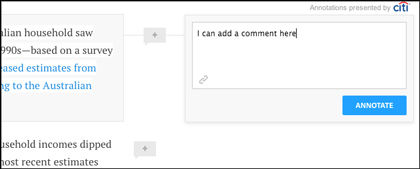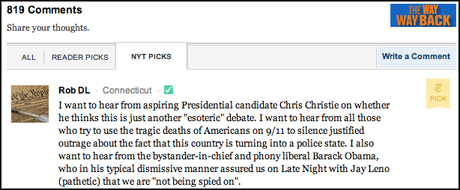
When it comes to building an active and high-quality community of commenters, most news sites understand they need to do more than provide a platform and then sit back and watch.
An earlier Journalism.co.uk feature highlighted the importance of keeping comments in check, and the potential impact of leaving strongly negative or abusive threads for others to see, and be affected by.
But when it comes to growing the quality of comments and the overall experience for readers, the answer goes beyond just banning those who refuse to play by the rules.
News outlets are consistently working to establish commenting environments and opportunities for their communities to engage in more meaningful ways, and there are a number of key strategies being implemented and proving successful.
Community and digital publishing experts from the New York Times, Guardian, Hearst Magazines UK, Quartz and Trinity Mirror Regionals - some of whom we originally spoke to for this podcast on comment strategy - share their practical tips below.
When to allow comments
One of the first decisions, beyond what platform you are going to use, is when to allow comments to be left in relation to a specific article. Some news outlets decide to close comments on articles for legal reasons, but there are other reasons why enabling commentary might not be appropriate.
At the Guardian, community manager Laura Oliver identified a list of points taken into consideration before comments are enabled. They will question whether it is an appropriate subject to carry discussion underneath and the right article, or whether a different piece on the same issue would be a more suitable home for the discussion.
News outlets also need to look to their resources and whether they are in a position to stay on top of the moderation necessary to ensure the best experience for their community.
"We're very much of the opinion that the best kind of conversation and best kind of interaction both for us and for readers of our site, comes from where there is some kind of management or involvement," Oliver explained.The best kind of conversation and best kind of interaction both for us and for readers of our site, comes from where there is some kind of management or involvementLaura Oliver, the Guardian
"Whether that's staff getting involved, or the writer of a piece, or whether it's strong moderation to make sure a tricky topic gets off on the right foot."
Certain subjects or people who appear within an article might be known for usually provoking a strong response, and so spotting those and considering the likely response can also play an important role in deciding the best way forward, she said.
Similarly, at the New York Times, the fact an article features comments is the result of a considered decision.
"We have always been selective on which stories we open up comments on," deputy editor for interactive news Marc Lavallee told Journalism.co.uk. And the inclusion of a commenting facility should therefore highlight to their audience that "there's some purpose behind it from our perspective", he added.
Zach Seward, who is a senior editor at business site Quartz – which earlier this week launched a new annotation-style comments feature on its articles – added that a lack of purpose is "one of the pitfalls that comment sections often fall in to".
Registration considerations
When the decision is taken to allow comments, it is time to bring on the discussion. But for those with less established commenting communities, there are some tips for how to encourage activity early on.
First, take a look at the registration process, Tom Miller, former community manager for Digital Spy, and now product strategist for owner Hearst Magazines UK, advises.
"Often when you do start with a new site or a relaunch, the problem and the biggest barrier to entry is usually the registration process," he said.Often when you do start with a new site or a relaunch, the problem and the biggest barrier to entry is usually the registration processTom Miller, Hearst Magazines UK
There is also the question of whether to allow anonymous commenting, or perhaps limit comments to a social login requiring people to comment with their social web persona.
Trinity Mirror Regionals, for example, took the decision to move to Facebook login for its comments earlier this year. Digital publishing director David Higgerson, who blogged about the move at the time, said this served to not only expedite the launch of its new websites, but also enhance the quality of conversation on those sites, although the quantity has dropped "quite significantly".
"What we do tend to find is that people are leaving more considered comments, are more respectful of each other when they're engaging with each other, and we feel that we do have nicer, more welcoming websites as a result."
This approach suggests that by using their social identities, commenters are more inclined to be civil and leave more respectful comments. But not everyone believes this will always have the desired effect.
"If you look at some of the things people say on Facebook groups or pages where they are commenting under their own name or certainly an identity linked to their personal life, I don't think that's always true," Oliver said. She also highlighted that some people adopt online identities which can be just as important to them as their real-life name, and so will act with the same responsibility.
She was also concerned that banning anonymous commenting could "close and quieten down debate and conversation", such as where people may not feel comfortable commenting about a personal issue, for example, in their name.
Giving some direction
For some would-be-commenters, knowing how they can best contribute to a comment section can be difficult. If there is a steady flow of comments already they may not know how best they can add to the discussion, or if things are looking quiet they might not feel confident to take that first step.
One way to help with this is for the journalist to offer direction ahead of the discussion, clearly signposting to readers at the end of their article what the main purpose of the comment thread is, and the best way they can make a useful contribution.
Where comments appear 'under the line' at the end of an article, for example, the Guardian likes to sometimes "frame" the discussion, such as by specifically stating what the comment thread is for, if they are looking for reviews of a film, for example.
"A little bit of direction can work really well," Oliver said. "I think particularly for those people who maybe aren't sure that they've got something to say.
"When you prompt someone and say 'we're not just looking for your opinion, we're looking for your knowledge or your expertise or your experience', it can really help give someone the courage to say 'actually I do have a lot to say on this particular subject'."
She added that not only does this help the commenter, but it can also prove fruitful for the journalist working on the story, who might find more thoughtful contributions offer up new leads for them.
At Quartz, its new approach to offering 'annotations' next to article paragraphs is another way of offering a clear direction for commenters, by giving them the ability to have conversations around particular points in the story.

"The paragraph acts as the discussion prompt," Seward explained, "and the hope is people will react to, add to, and otherwise annotate something very specific in that paragraph.
"A comment section can mean many different things to different people and without an organising principle or discussion prompt, it's hard to really even know what to use it for."A comment section can mean many different things to different people and without an organising principle or discussion prompt, it's hard to really even know what to use it forZach Seward, Quartz
The value of journalist involvement
Whether it is to encourage activity in the first place, or to be involved once discussion is underway, being active in comment threads as a journalist, is hugely important. It is advised, for example, to respond to questions about your work, or just to show an interest in the conversation.
Not only does this help demonstrate to communities that they are being heard, it has also been found to help focus the discussion early on and keep a higher quality of conversation.
"We know from studies we've done it really drastically reduces the need for moderation," Oliver said, and Bassey Etim from the New York Times added that this is another way to "show respect" as a news outlet to those who are contributing to your product, and it "really does improve the quality of the conversation".
"Just the idea that there's an 'adult in the room' watching everything keeps everybody, trolls and reasonable commenters alike, on their toes."Just the idea that there's a 'adult in the room' watching everything keeps everybody, trolls and reasonable commenters alike, on their toesBassey Etim, New York Times
"They don't want to be exposed as just another mindless commenter when there's a journalist around," he added.
Interestingly, the growing use of social media by journalists has meant the practice of getting involved in the comments is on the increase, at least at Trinity Mirror regional titles, according to Higgerson.
And when journalists are in the threads, "people don't just feel that they're posting into an empty space", he said.
Offering ways to sort the chaos
The quality of the comments is not the only factor which can help determine the end user experience – quantity can play a part too. And if your news site often has hundreds of comments underneath an article, it might be worth considering if there is any way to make this more manageable, or useful, for readers.
News outlets take different approaches to how they sort comments, some simply offer chronological ordering, while others offer the ability to push 'better' comments higher up the thread.
When it was using Facebook comments, Digital Spy, for example, used to be able to "boost" what it considered the best comments. This is not possible on its new system at the moment, but it is looking at similar strategies for the future.
"There are ways around it which we need to spend a lot more time on," Miller said, "particularly now people are on mobiles where the experience on a smaller screen is just by no means ideal."
Lavallee said for the New York Times, ensuring a good user experience for readers is vital, with efforts to avoid giving them an "inbox problem" with hundreds of comments to get through.
To tackle this, under articles on the New York Times, for example, comments are sometimes sorted into collections of 'Readers' Picks', and/or 'NYT Picks'.

Another tactic is to organise comment threads into different groups of conversations. The Guardian's platform lets commenters reply to specific comments. The resulting conversations, which may be lengthy discussions, and which may occur within a thread containing others too, can now be collapsed into 'nests' so that others arriving to the story can choose whether to dive into those 'nests' in more detail, or just sample a snapshot of them.
"They'll be able to more quickly look at what's been said already, look at the different nests of conversation that there are, and find the one that interests them most, without getting distracted or thinking that the first conversation is the whole discussion," Oliver explained.
Recognising and rewarding key commenters above the line
Partly in a continuation of the above strategies for bringing some order and added value to the world of comments, the New York Times has also started experimenting with bringing certain comments above the line.
Just last week the Times introduced Readers' Perspectives alongside one article, selecting the best parts of the comment thread and highlighting those to readers.

This serves to not only give greater status to comments and reward those who offer those contributions, but helps present the wider conversation and alternative viewpoints to readers in conjunction with the narrative.
The selection of comments is made based on a number of factors. The team look for a collection of perspectives which offer varying viewpoints, for example, the more succinct arguments putting across clear points, or even "extreme opinions that really catch the essence of a wide range of feeling".
The aim is "to create a clip notes version of the comment thread so you don't have to spend a lot of time trying to figure out what people think on a particular issue", Etim explained.
News outlets have also found other ways of recognising the best voices in its threads, and are also bringing those comments 'above the line'.
At the Guardian, for example, Comment is Free run a Comment of the Week, and also give the world of comments "a more human face" by getting to know certain commenters better in Below The Line.
Some comments may also find their ways into liveblogs, or play a part in editorial decisions or follow-ups. "It shows people that you're taking it seriously and that we're actually reading the comments that go under our articles," Oliver said.
Quartz's new annotations feature also works to "reward a really thoughtful contribution", Seward said, while Miller added that making sure thoughtful comments are able to inform future editorial is very important for Digital Spy. And this in turn can serve to welcome more commenters to join in, Higgerson said.
"You don't need many comments to open the floodgates to more comments by doing things such as repackaging comments on a particular story into an article in its own right .
"You write the article, you get the comments, turn those comments into an article. That then brings on more comments."
As well as bringing comments above the line, The New York Times also sometimes takes them out of article pages and onto the homepage, where the Times wants to highlight both the article and "the best of that conversation".
Etim added that these strategies show the community respect, and this delivers quality in return.
"When you show respect for people, whether it be through creating these really cool interactive commenting formats, or whether it be through trying to get a reporter in the thread talking on the same level as the readers, it really does improve the quality of the conversation."
Innovating for the future
The recent experiments in how comments are integrated into online articles at the New York Times, Quartz and elsewhere – such as by Medium which offers 'notes' at the side of its posts – come at a time when the industry is excitedly experimenting with new digital publishing formats, and the comment thread is being required to evolve alongside it.
Long-form multimedia features, for example, which do not conform to traditional article layouts, have caused news outlets to think about where the community's conversation can exist alongside that.
The New York Times's much-discussed Snowfall feature, for example, was "a bit of a wake-up call for comments in general", Lavallee said. In the case of Snowfall, there was a separate page where comments were gathered.
"It garnered great conversation," Lavellee said, "but I think the vast majority of people who read Snowfall didn't see it."
"I think that influenced a lot of our thinking going into this year, particularly with these major enterprise stories that we as an organisation put a lot of effort behind, to find, in the right situations, the right ways to treat the reader voice as a visual element in the same way that we treat graphics, video, etc."
Miller argued that with this style of digital storytelling, annotation is the way forward.
"When you look at things like Medium and SoundCloud, where you can essentially annotate as you read or as you listen, in the same way that you might on a Kindle, I think that's the right direction to head in.Anything that gives comments a more prominent slot in an article can only be a good thing if the publisher has a serious commitment to valuing those commentsDavid Higgerson, Trinity Mirror Regionals
"Apps are doing this so much faster than publishers for the most part, so it's good to look at them I think for inspiration where we can."
This presents many questions – such as where to deliver those annotation opportunities, or 'reader perspective' boxes, a point raised by Higgerson.
"But anything that gives comments a more prominent slot in an article can only be a good thing if the publisher has a serious commitment to valuing those comments," he added.
"And that's a very good way of showing that you value what people are saying by giving them such prime real estate in the article".
- This guide acts as a follow-up to this how-to from 2011 by eModeration's Tamara Littleton on managing comments across platforms, and moderation advice
Update: Please use the comment section below to share any strategies you have which have helped boost the quality of comments or the experience for readers in general.
Free daily newsletter
If you like our news and feature articles, you can sign up to receive our free daily (Mon-Fri) email newsletter (mobile friendly).
Related articles
- Five key takeaways from the UK select committee on the future of news
- From Reuters to The New York Times, Big Oil pays 'most trusted media brands' to push greenwashing
- Standing out in a crowded market: what makes a top news podcast?
- How do we tell stories of people neglected by the media?
- Guardian launches a new section for readers in Europe









